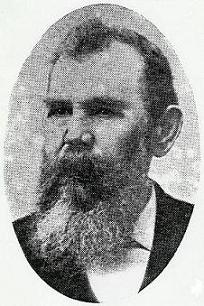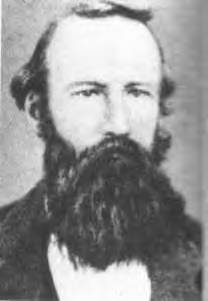Benjamin Simms Fitzgerald: Pioneer Educator

Benjamin Simms Fitzgerald, educator, soldier, and businessman, was born in Johnston County, North Carolina, in 1828. The son of Gisborn and Mary Fitzgerald, he spent much of his early life in Mississippi. He was working as a sawyer at the time the 1850 census was taken in De Soto County. He moved to Texas in 1851, settling in the country about fifty miles from what is currently Waller County (but was then part of Grimes County) where he taught school for several months. At the December 13, 1851, meeting of the Baylor University board of trustees, he was elected tutor in place of a Mr. Edwards who had resigned. Between 1851 and 1854, he taught ancient languages, mathematics, and moral and intellectual philosophy. At Independence, on January 19, 1854, he married Harriet ("Hattie") Louise Davis, sister-in-law of Horace Clark. He resigned his position in 1854 and moved to Travis County where he conducted a country school near Austin until 1857 when he was persuaded to return to Baylor.
In 1859 and 1860, and again in 1863 and 1864, Fitzgerald was professor of languages and principal of the preparatory department. He was one of seven faculty members of the Male and Female Departments who in mid-March 1861 signed a circular refuting rumors of animosity between the two departments. At the March 12, 1862, meeting of the Baylor board of trustees, Fitzgerald proposed to sell his house and lot at Independence to the university for use as a boarding house for the Female Department. The board declined the offer due to a desire not to incur any further large liabilities during the "pecuniary embarrassment of the country."
At Independence on March 22, 1862, Fitzgerald enlisted in Company I of the 5th Texas Infantry Regiment, Hood's Brigade, Army of Northern Virginia. He became ill and on August 7, 1862, was left at Richmond, Virginia, where he was hospitalized on the 15th. In November or December, he was furloughed to Texas where he remained until about May 1864. While on furlough he was engaged as a professor of ancient languages in Baylor's Male Department and on February 5, 1864, was appointed collection agent for income on the endowments and the tuition of the Male Department. However, on March 26, 1864, he was instructed at the request of the faculty not to collect the interest on the endowment fund for the time being. By late spring 1864, he had returned to the army where on January 24, 1865, he was chosen chairman of a meeting of officers and men of the Texas Brigade which protested plans to consolidate it with one or more other brigades and passed resolutions affirming the brigade's continuing faith in the Confederacy. At Appomattox Court House, Virginia, on April 10, 1865, he was paroled to return to his home in Texas.
In 1865 and 1866, Fitzgerald was a professor of mathematics and natural sciences at Baylor. At the July 8, 1865, board of trustees meeting, during which he was elected professor of mathematics, it was ordered that the A.M. degree be conferred upon him. His resignation was received and accepted on February 8, 1866. In June 1866, Horace Clark, principal of the Female Department, was granted a twelve-months leave of absence, provided he secure the services of Fitzgerald and a sufficient number of teachers to keep the department operating. During Clark's absence, the Female Department was made Baylor Female College, and Fitzgerald thus became its first president, serving in that capacity until Clark's return.
Fitzgerald moved to Houston in 1868 and in 1870 and 1871 was a professor of mathematics. He may have contemplated a return to Baylor, for a Baylor circular issued in August 1872 announced him as professor of mathematics and natural sciences. By 1873 he was principal of the Houston Academy, a position he held until 1875. During these years he engaged himself in a number of enterprises. He was a dealer in religious and denominational books in 1873. In 1874 he was associated with University Publishing Company's Houston agency and in 1874 and 1875 was an agent for Western Publishing and School Furnishing Company. In connection with the American Journal of Education, Fitzgerald in 1874 was involved in a publishing venture called Texas Education. He wrote Baylor's William Carey Crane on July 1, 1875, stating his desire to work for the railway postal service in Texas.
The 1877/'78 Houston city directory listed Fitzgerald as "emigration agent Houston and Texas Central Railway." He was listed in the 1882/'83 directory as a bookkeeper for the M. T. Jones (lumber) Company. By 1886, he owned his own lumber company and remained in the lumber business through the 1890's. A week after his and his wife's golden wedding anniversary, Benjamin Simms Fitzgerald died at the residence of his daughter Mrs. James L. (Mary) Bates (1418 Rusk Avenue) at 10:48 a. m., January 27, 1904. Obituaries state that interment was to have been in Hollywood Cemetery. Fitzgerald is buried in Glenwood Cemetery. He was a lifelong member of the Baptist Church.
Deed records indicate that Fitzgerald may have considered a move to Brazoria County. He purchased 9.91 acres from W. Zychlinski in May of 1894; however, he sold it in August of the same year to W. J. Larkin. In March of 1895, Fitzgerald purchased lot 23 block 9 in the town of Pearland. In November 1913, B. S. Fitzgerald, Jr., Mrs. Frances Underwood, R. S. Collins and wife Carrie L. Collins quit claimed the lot to Mrs. James L. (Mary) Bates. James Love Bates, who was the husband of Mary (Fitzgerald) Bates, was at one time the county treasurer of Brazoria County and was the son of Confederate Army Colonel Joseph Bates, commander of the regiment he raised for coastal defense, known as Bates's (13th Texas Infantry) Regiment. James and Mary Bates were the parents of a son named Fitzgerald Bates.


